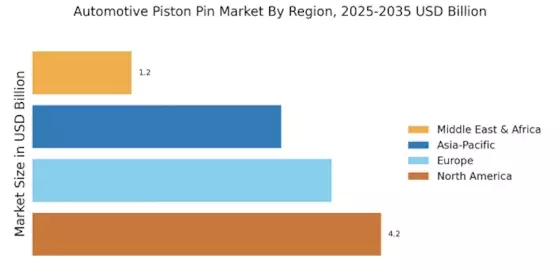Growth of Aftermarket Services
The Automotive Piston Pin Market is witnessing a notable expansion in aftermarket services, which is becoming a vital driver for the market. As vehicles age, the need for replacement parts, including piston pins, increases. This trend is particularly pronounced in regions with a high number of older vehicles still in operation. The aftermarket segment is projected to grow at a rate of approximately 4% annually, driven by the rising awareness of vehicle maintenance and the importance of using quality replacement parts. This growth presents opportunities for manufacturers to diversify their product lines and cater to the needs of the aftermarket, thereby enhancing their market presence and profitability.
Increasing Vehicle Production Rates
The Automotive Piston Pin Market is significantly influenced by the rising production rates of vehicles across various segments. As consumer demand for automobiles continues to grow, manufacturers are ramping up production to meet this demand. According to recent data, vehicle production is projected to reach approximately 100 million units annually by 2026, which directly correlates with the demand for piston pins. This increase in vehicle production not only boosts the sales of piston pins but also encourages manufacturers to enhance their product offerings to cater to diverse engine designs and specifications. Consequently, the market for automotive piston pins is expected to expand, driven by the need for reliable and efficient engine components.
Rising Demand for Lightweight Components
The Automotive Piston Pin Market is experiencing a notable increase in demand for lightweight components, driven by the automotive sector's focus on enhancing fuel efficiency and reducing emissions. Manufacturers are increasingly adopting materials such as aluminum and advanced composites to produce piston pins that are lighter yet durable. This shift not only contributes to improved vehicle performance but also aligns with regulatory standards aimed at minimizing environmental impact. As a result, the market for lightweight piston pins is projected to grow significantly, with estimates suggesting a compound annual growth rate of around 5% over the next few years. This trend indicates a robust opportunity for manufacturers to innovate and cater to the evolving preferences of automotive manufacturers.
Regulatory Compliance and Emission Standards
The Automotive Piston Pin Market is also shaped by stringent regulatory compliance and emission standards imposed by governments worldwide. As regulations become more rigorous, automotive manufacturers are compelled to develop engines that meet these standards, which often necessitates the use of advanced piston pin designs. These designs are engineered to optimize engine performance while minimizing emissions, thereby ensuring compliance with environmental regulations. The increasing focus on sustainability and eco-friendliness is likely to drive demand for innovative piston pin solutions that enhance engine efficiency. As a result, manufacturers that prioritize compliance and invest in research and development are expected to gain a competitive edge in the market.
Technological Innovations in Manufacturing Processes
Technological advancements in manufacturing processes are playing a crucial role in shaping the Automotive Piston Pin Market. Innovations such as precision forging, advanced machining techniques, and additive manufacturing are enhancing the production efficiency and quality of piston pins. These technologies enable manufacturers to produce components with tighter tolerances and improved performance characteristics. Furthermore, the integration of automation and robotics in manufacturing processes is expected to reduce production costs and lead times, thereby increasing competitiveness in the market. As the industry continues to embrace these technological innovations, it is likely that the overall market will witness a surge in demand for high-performance piston pins, particularly in high-performance and luxury vehicles.


















Leave a Comment